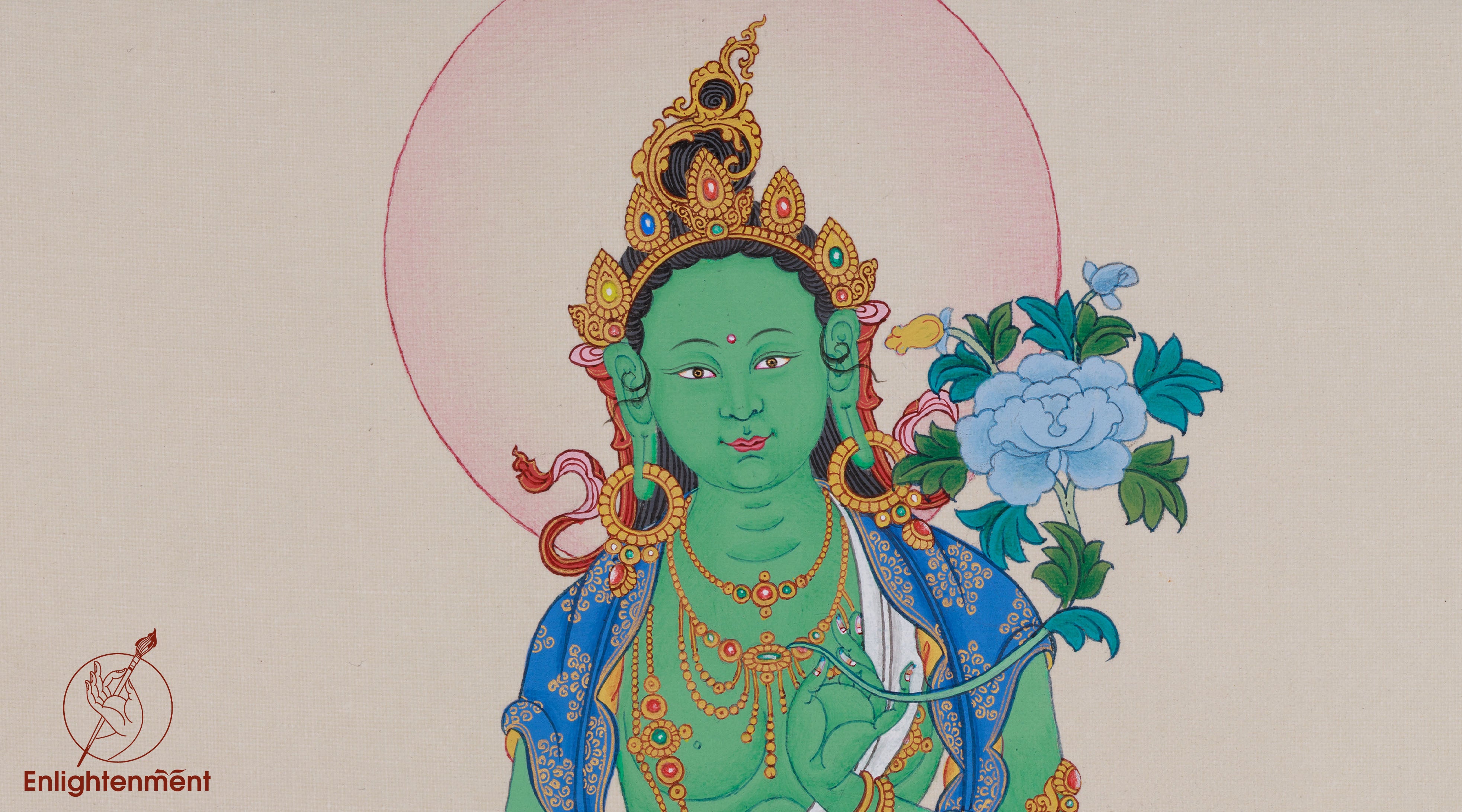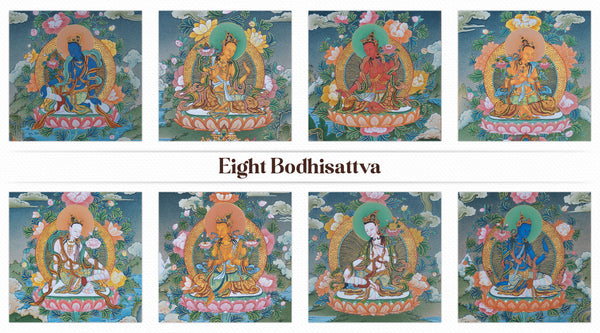Find the Ideal Tara Thangka for Your Practice
Tara is the "Mother of Liberation," who embodies compassion, wisdom, and protection. She is one of the most beloved and revered female bodhisattvas in Tibetan Buddhism. Hence, the Mother is often called upon for her protection, guidance, and to remove obstacles on the path to enlightenment.
For devotees, having a Tara thangka in their meditation space can greatly enhance their connection to her compassionate energy. So does the practice of her mantra. But what should you consider when buying a Tara thangka for your practice? Let’s explore this in detail, covering everything from her different forms and mantra practice to thangka quality and iconography.
Introduction to Tara and Her Many Forms
The committed adherents can choose which Tara to focus on based on their personal needs and spiritual goals. Each form of Tara carries a unique energy, hence it is essential to understand the various types before choosing a thangka.
The Practice of Tara's Mantra

One of the most key elements of Tara practice is the recitation of her mantra. The Green Tara mantra goes like this:
"Om Tare Tuttare Ture Soha"
This mantra invokes the revered female Bodhisattva's swift action to remove fear and suffering. Devoted practitioners consider this mantra recitation to be a powerful tool for connecting with the Mother's compassionate energy and receive her blessings. Hence, this mantra has become a popular practice among Tibetan Buddhists in meditation, prayer, and ritual.

Similarly, The mantra of White Tara is written below:
"Om Tare Tuttare Ture Mama Ayuh Punya Jnana Pushtim Kuru Svaha"
The mantra calls for health, longevity, and wisdom. When reciting Tara’s mantra, having a thangka depicting her helps practitioners visualize her form, enhancing their connection to her qualities. This is where selecting the right Tara thangka becomes crucial. The thangka serves not only as a piece of sacred art but also as a visual aid for deepening one’s meditation practice.
What to Look For When Choosing a Tara Thangka
There are various aspects to look after when considering purchasing a Tara thangka to enhance your shopping experience and your spiritual perception. Take a note of those elements mentioned below:
- Iconographic Accuracy
- Aesthetic Value
- Quality of the Thangka
- Size Considerations
- Price Range
- Brocade Selection
1. Iconographic Accuracy
Iconography is essential when selecting any Tibetan thangka, as the depiction of deities follows strict guidelines. Tara’s form must adhere to these guidelines to ensure that the energy and symbolism in the artwork remain intact.
-
Green Tara is often shown seated in a posture of readiness, with one leg extended, symbolizing her willingness to spring into action. She holds a blue lotus in her left hand, and her right hand is in the gesture of granting boons.
-
White Tara sits in a more relaxed lotus posture, often with an open lotus in her hand, representing purity. Her seven eyes—one on each palm, foot, and forehead—symbolize her all-seeing compassion.
- 21 Forms of Tara incorporates the 21 different forms of Bodhisattva Tara, including the Green and White Tara. Here, each of the 21 Tara is depicted with distinct attributes, postures, and colors, symbolizing various qualities and functions.
It is important to ensure that the Tara thangka follows these traditional forms as it is essential for its use in mantra practice and meditation. Deviations from traditional iconography may not only detract from the practice but may also disrupt the energy that the thangka is meant to convey.
2. Aesthetic Value
While iconographic accuracy is paramount, aesthetic appeal plays a vital role as well. A visually pleasing thangka inspires devotion and creates a conducive environment for meditation. Consider the following elements:
-
Color Palette: Traditional thangkas use vibrant colors like gold, deep blues, and greens that symbolize different aspects of the deity’s nature. For example, the green hue of Green Tara symbolizes active compassion and protection.
-
Artistic Detailing: Pay attention to the intricacy of the details. Thangkas are rich in symbolism, and even the smallest elements, such as Tara’s jewelry or the background landscapes, carry spiritual meaning.
3. Quality of the Thangka
When purchasing a Tara thangka, the quality of the materials and craftsmanship is crucial. There are both hand-painted and machine-made thangkas available. For those looking for a long-lasting, high-quality piece, hand-painted thangkas are often preferred as they are created by skilled artisans who devote meticulous attention to detail.
However, machine-made thangkas can be a more affordable option while still maintaining a certain level of craftsmanship. When selecting, look for:
-
High-Quality Paints: Natural mineral pigments are traditionally used, offering a vibrant and long-lasting finish.
-
Durability: Ensure the thangka is made on high-quality cotton or silk canvas that will stand the test of time.
-
Embroidery and Gilding: Some thangkas feature gold leafing and intricate brocade borders, which add to their aesthetic and spiritual value.
4. Size Considerations
Thangkas come in a variety of sizes, from small pieces suitable for personal altars to larger ones designed for shrine rooms or temple spaces. The size you choose depends on your available space and how you plan to use the thangka. If it's for personal meditation, a smaller size may be sufficient. For a communal space or a home altar, a larger thangka can make a bold statement and draw more focus during prayer and mantra recitation.
5. Price Range
Prices for Tara thangkas can vary widely based on factors like size, materials, and the level of craftsmanship. Hand-painted thangkas by renowned artists can be quite expensive but are considered valuable spiritual investments. Machine-made versions are more budget-friendly, making Tara’s image accessible to a wider audience.
6. Brocade Selection

Brocade is the ornamental silk fabric that often frames a thangka. The selection of brocade adds an additional layer of aesthetic and spiritual significance. Traditionally, gold and red brocade are used, symbolizing the deity's radiance and power. High-quality brocade enhances the beauty of the thangka and adds a regal touch to your altar or meditation space.
When selecting brocade, consider how it complements the thangka. For example, gold brocade can elevate the luminosity of Green Tara’s emerald hue, while red brocade can enhance the calming energy of White Tara’s serene form.
The team of Enlightenment adheres to each of your needs and offers top-notch quality for Tara in your space. Refer to our Brocade section for your queries.
Final Thoughts on Selecting Your Tara Thangka
A thangka is more than just an artwork; it is a sacred tool for deepening your spiritual practice. Whether you are drawn to the swift, protective action of Green Tara or the healing energy of White Tara, the right thangka can help cultivate a closer connection to the divine.
By paying attention to iconographic accuracy, aesthetic value, craftsmanship, and other factors such as size and brocade selection, you can ensure that the Tara thangka you choose will be a powerful addition to your meditation practice and a beautiful piece of sacred art that lasts for generations.
Remember, selecting a thangka is a deeply personal process. Take your time, feel a connection with the artwork, and trust that the right Tara thangka will resonate with your heart and spiritual journey.



